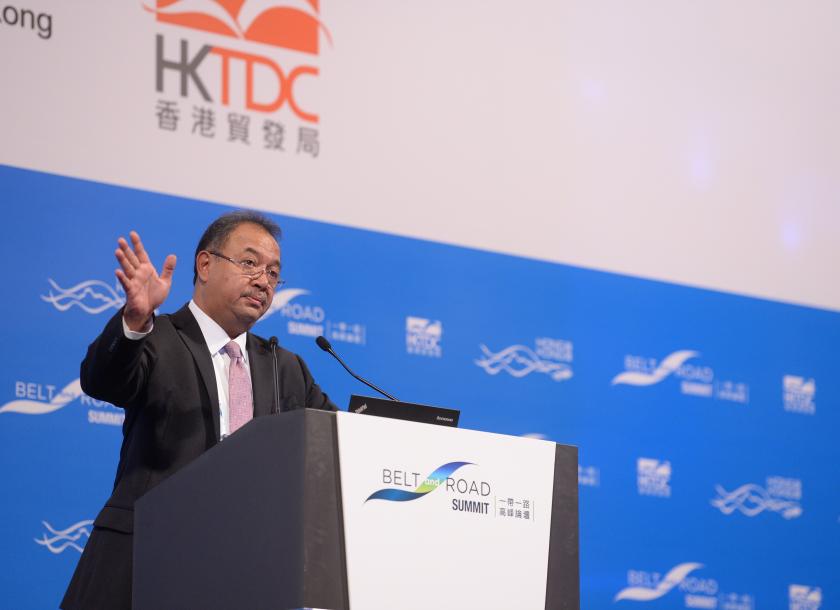ASEAN countries “keen” and “ready” for Belt and Road: HKTDC
AS the top destination of Chinese investments, ASEAN means business when it comes to the Belt and Road Initiative (BRI), a trade body said. The initiative is expected to require “staggering” infrastructural investments in Asia’s developing economies.
Jointly organised by the territory’s government and its trade body, the Hong Kong Trade Development Council (HKTDC), the Belt and Road Summit, under the theme “from vision to action”, was held on September 11 in the city.
The city’s leader, Carrie Lam, said during the event that ASEAN economies and geography make the regional bloc a key part of Beijing’s grand design.
Not only is ASEAN strategically located on the Belt and Road routes, the region’s emerging economies are seen as future drivers of the regional and global economy.
– Carrie Lam, Hong Kong Chief Executive
“Undoubtedly, ASEAN will continue to be a focal point for the Belt and Road, with a number of major collaborative projects already under way in the region,” she observed.
ASEAN “more ready”
The Myanmar Times asked Vincent Lo, chair of HKTDC, about ASEAN’s position in the BRI compared to Eastern Europe and Central Asia.
“The ASEAN countries are more ready [to work with the Belt and Road]. They are ready. They are keen. Business will be done. I have no doubt about that,” Mr Lo told The Myanmar Times, adding the fact that the two high-level investment delegations he led were to ASEAN countries speaks for itself.
In May, a Hong Kong-Shanghai infrastructure investment organised by the trade body visited Bangkok, Hanoi and Ho Chi Minh City, during which they were received by Thai Prime Minister General Prayut Chan-o-cha and Vietnam’s Prime Minster Nguyen Xuan Phuc.
 Vincent Lo, chair of Hong Kong Trade Development Council, speaks to The Myanmar Times during a sideline media interview. Photo: The Myanmar Times/ Thompson Chau
Vincent Lo, chair of Hong Kong Trade Development Council, speaks to The Myanmar Times during a sideline media interview. Photo: The Myanmar Times/ Thompson Chau
“It is such a big pie. You need everybody. You need the whole world’s resources to try to get the BRI really up and running. We are now just scratching the surface.
“With the infrastructure built, there will be a lot of investment going to all these places. If you look at China in the past 30 odd years, it started with infrastructure as well,” the HKTDC chair went further.
Mr Lo emphasised again and again during the media interview that Hong Kong would only facilitate projects purely from a commercial perspective. Politically-charged projects are done by the leadership in Beijing, though he refused to comment on individual projects.
“Theirs [China’s efforts to promote the BRI] is more politically driven. Obviously, Beijing will have their own agenda on who to invest in. But from Hong Kong’s perspective, we are looking at it purely from a business viewpoint.
“Hong Kong is looking at it [the BRI] commercially,” he said. For politically-driven projects, project stakeholders will need to go to Beijing for investment.
Many Hong Kong and Southeast Asian businesses view ASEAN as a core part of the BRI.
The ASEAN countries are more ready. They are ready. They are keen. Business will be done. I have no doubt about that.
– Vincent Lo, Hong Kong Trade Development Council
Bernard Charnwut Chan, president of Asia Financial Holdings, argued earlier that ASEAN and Myanmar’s geographical proximity to China will create immediate synergy and allow projects to take off more quickly. Research conducted by the Economist Intelligence Unit reveals that over 60 percent of Chinese overseas direct investments in BRI countries in 2013-15 are directed at the ASEAN bloc.
Speakers at the first panel agreed that policy coordination among governments is essential to the Belt and Road Initiative, as are the relaxation of restrictions, the removal of barriers and the promotion of investment, trade and commerce. Virasakdi Futrakul, Thailand’s deputy minister of foreign affairs, praised the city as a “strategic buckle” in the scheme.
The second panel spotlighted ASEAN economies which have undergone rapid economic growth in recent years.
Asia’s “staggering” infrastructural investment
The Belt and Road blueprint requires “staggering” infrastructural investment in Asia’s developing economies, according to the Asian Infrastructure Investment Bank (AIIB).
Luky Eko Wuryanto, AIIB Vice President, noted that the institution is interested in investing in infrastructure projects regardless of whether they are part of the Belt and Road framework.
Asia’s developing economies need a “staggering level” of infrastructural development that they can’t afford on their own, he stressed. South Asia in particular has been left behind in the region’s development drive, which started in Japan in the 1980s, continued in South Korea in the 1990s, and has dramatically transformed China over the last two decades.
Mr Wuryanto described the AIIB as a “new kid on the block”, founded only recently with a focus on the development of infrastructure and sectors including energy and power, transport and telecommunications, rural infrastructure and agriculture development, water supply and sanitation, environmental protection, urban development and logistics.
The institution has a key role in negotiating the envisaged “cross-country connectivity”, while ensuring that “no country is left behind.”
“Shared benefits should be clear and fair for all involved,” he said.
While developing Belt and Road countries have been left behind in infrastructural development, he said they also face the challenge of huge population growth and urbanisation, with more than three billion, or half of the world’s population, gravitating to cities by 2050. At the same time they are grappling with the impact of climate change and environmental degradation.
The big question is how to unlock their potential without aggravating existing pressures, he went on.
The AIIB’s answer is “brand new approach – being lean, clean and green” with sustainable development. “We have to look for development solutions while also protecting a fragile environment,” he concluded. “That’s the key.”
Source: https://www.mmtimes.com/news/asean-countries-keen-and-ready-belt-and-road-hktdc.html


 Thailand
Thailand




